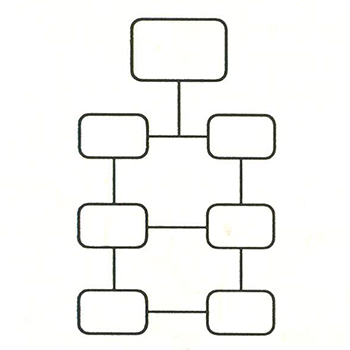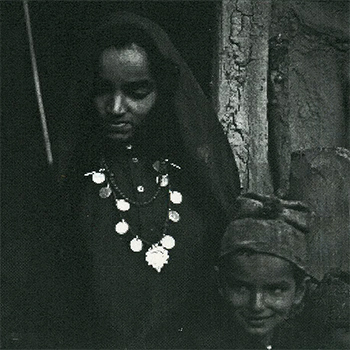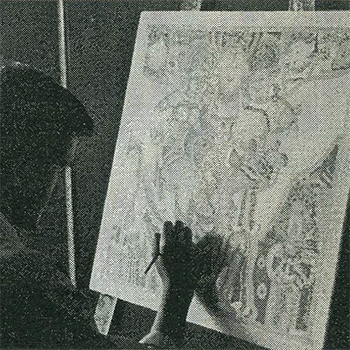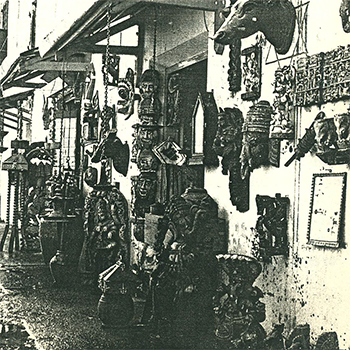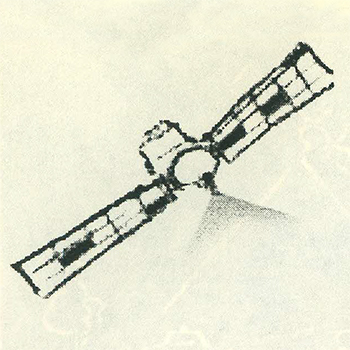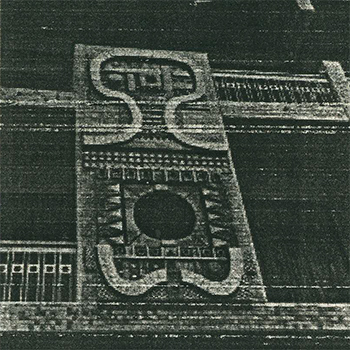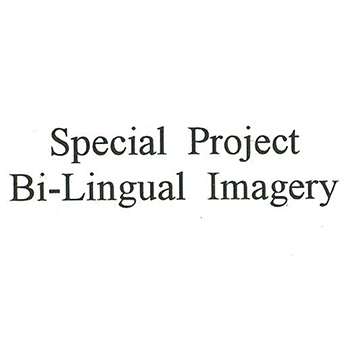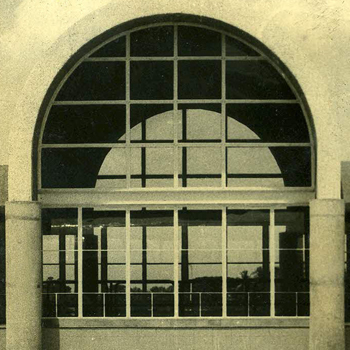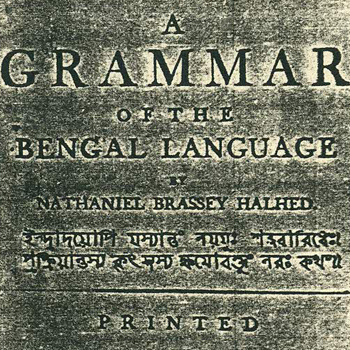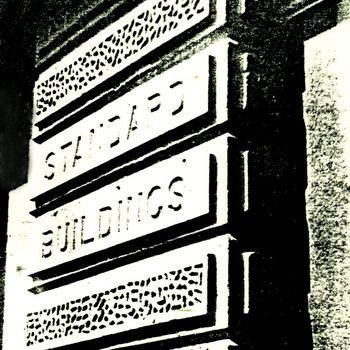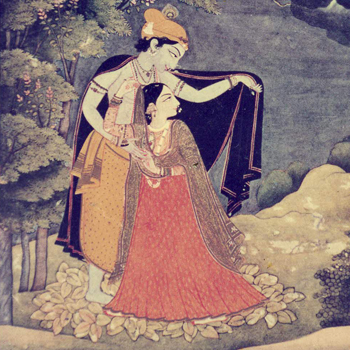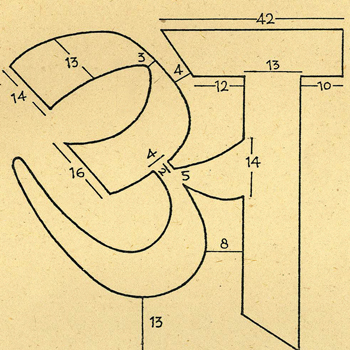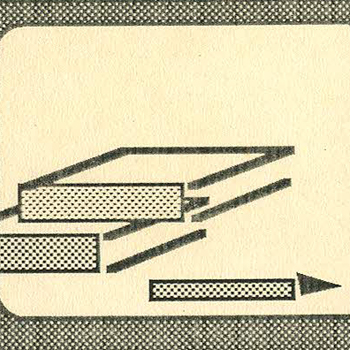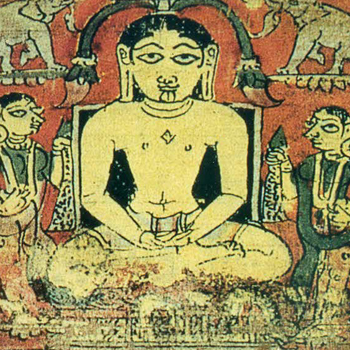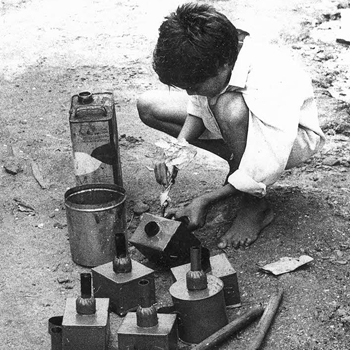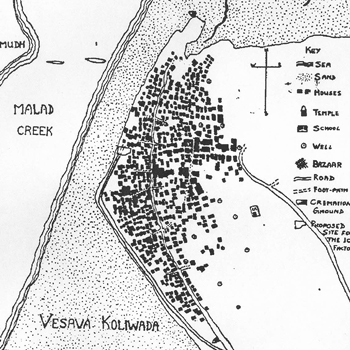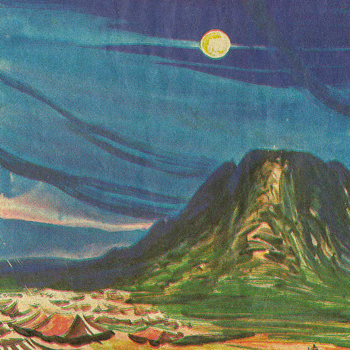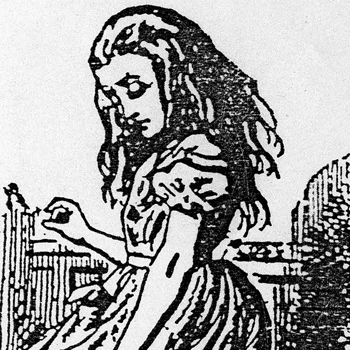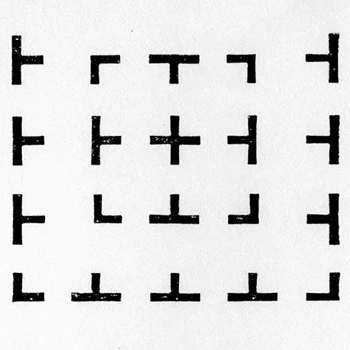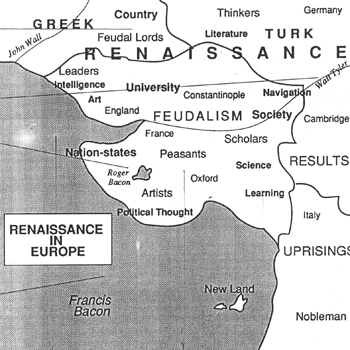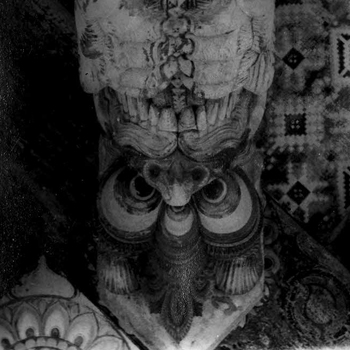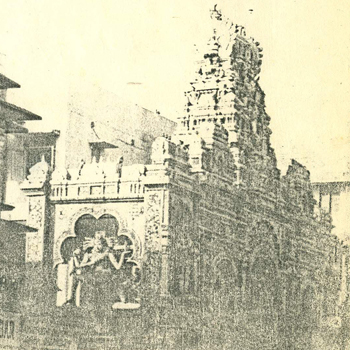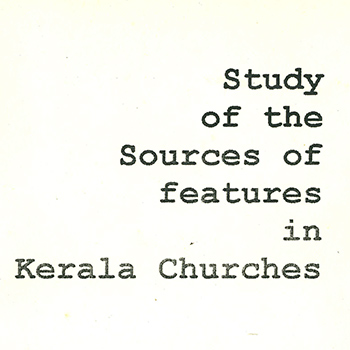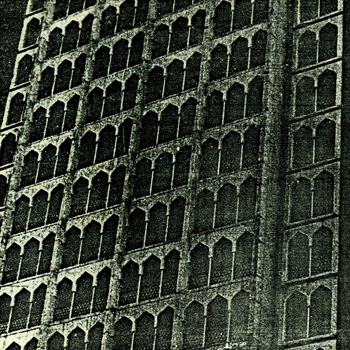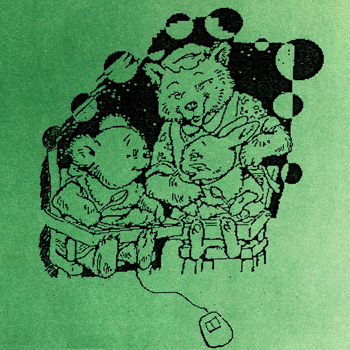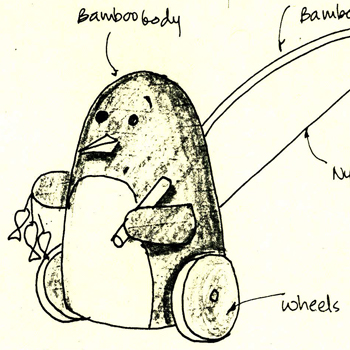M.Des Communication Design 1989-1998
Batch 1996-1998
(15 items)
Batch 1987-1989
(8 items)
Batch 1988-1990
(8 items)
Batch 1989-1991
(6 items)
Batch 1990-1992
(7 items)
Batch 1991-1993
(9 items)
Batch 1992-1994
(6 items)
M.Des Communication Design 1989-1998
1996-1998
(15 items)
by Anoop R
Vastuvidya is derived from "Vas," meaning "to dwell" or "to occupy." The vastus refers to all mortal and immortal dwellings. The science of designing and building vastu, or vastusatra, originated in the Vedic period. Kerala in the olden days had adopted the concepts of architectural engineering from Vastuvidya or Vastusatra, which is also known as Sthapatyaveda or Vastusilpa.
Vastusastra, as a science, takes a systematic approach to the planning, design, and construction of Vastu from concept to completion, based on certain thumb rules. But most of the concepts are shrouded in mystery. Most of the time, the theories of this traditional science are explained in a spiritual or philosophical manner. But a scientific approach to this subject may be useful for familiarising the common people with this traditional science.
We can discover some scientific facts hidden in the texts of Vastu, written purely in a spiritual or philosophical language. The Acharyas or Sthapathis who wrote those texts might have also thought scientifically, but the style they used for representation was purely mythical. So in order to translate them into the present world, a new channel of thought has to be opened without disturbing the sacredness of the past. This is a relatively difficult task and, most of the time, impossible as well. But it may be that only with this translation process, the essence of the traditional system be made popular and practised in the present world.
This project aims to connect some of the traditional building concepts used by the sthapathis with modern reasoning. The traditional residential and secular architecture of Kerala is taken as a backdrop to the study. So this project includes some case studies of traditional Kerala dwellings used for constructing buildings and some modern scientific principles that can be related to Vastu principles.
by Kaladhar Bapu
In enormous variety of software packages for designers and other creative professionals is available today. These range from small paint packages like Paint Brush that come with any standard Windows installation to more independent commercial packages like Corel Draw: From advanced painting software like Adobe Photoshop to cutting-edge 3D rendering and animation software like Alias Max and others, The aim of this project is to fully explore and apply design principles to any one of the mentioned softwares, my choice being paint packages such as Photoshop, Fractal Design Painter, and Power Goo. The packages mentioned herein can be broadly classified into two groups, namely, paint packages and animation packages.
The versatility of animation software is well known, and so the possibility of using features of paint packages for creating animations, etc., is being studied in my special project. Hence, I have chosen to work with Photoshop and Fractal Design Painter with all the plug-ins that are compatible with these packages.
by Kamlesh Saxena
Exploring various levels and the surface of information in multimedia, linking information through pathways, and organising it within a basic structure allows it to be put to better use and build a convenient, simple, and easy-to-interact multimedia environment.
Integrating various media together seamlessly facilitates effective use of text, graphics, animation, video, and audio through input and output devices, making for a better multimedia.
Until now, the information contained in any medium had a linear structure, i.e., it was not governed at the user’s end but structured by the designer. What makes multimedia so different is that the entire information can be designed as per the user’s need, i.e., on his request for a story, a message, or an idea. The information is no longer linear as the user has freedom of navigation, he can choose his own path. At the same time, the medium has excellent linking potential.
by Khyati Nagar
Accessories are of course only a part of body decoration, and it is only through mental separation that we can separate body modifications and supplements from the body itself and from each other and extract what we call adornment. Most of the data I could collect concentrated mainly on jewelry, and through these I shall cover the first category, though body painting, tattooing, scarification, and the filling or extraction of teeth are equally important. Most involve more permanent and dramatic transformations (some examples of this are included here) than does the wearing of jewellery. Movements and gestures are also relevant. Indeed, these may be so characteristic that they may be reproduced so as to suggest the presence of adornment even when, in fact, it has not been worn. Igbo women in Nigeria, for instance, typically wear heavy brass anklets of plate-like proportions, which cause them to have a rolling gait as they walk. This style of movement is often imitated by those who are not adorned in this way to suggest that they too are accustomed to decorating in such a prestigious manner.
Jewellery is also set apart from other means of transforming physical appearance in that it appears familiar; we think we know what it is and what it does. However, although the physical alteration of the body may be regarded as an act of beautification by those who practise it, it is often characterised by others as barbaric and brutish.
by Kshitija Patole
Every society and its people have simple, practical, and useful knowledge, which is often expressed most creatively and effectively by the people of that society through their tales and toys. Thus, each region has a different and unique character that is reflected through these sources. These craftsmen have unique ideas for playthings that become popular in their areas. Many a times the basic principle behind the toy in many regions might be the same, but they reflect the look of the society from which it belongs to.
Today in the markets, you do get to see low-cost toys that are everyday playthings for millions of Indian children, past and present. But as compared to the past, toys made of clay are rarely seen. Most are factory-made toys using materials like plastic, metal, wood, etc.
To get back into the past, it is interesting to find that the folk toys of India, particularly those found at the excavated sites of ancient centres of culture, show very striking similarities to those discovered in Crete and ancient Egypt. As far as India is concerned, the most ancient toys of which we have any record belong to the period of the Indus Valley Civilization, dating from 2500 to 1700 BC, and bear a surprising affinity to the hand-made folk toys of a much later date. At the ancient sites of Mohenjodaro and Harappa have been found terracotta toys representing human figures, farm carts, cows, sheep, pigs, oxen, birds and animals, rattles, whistles, balls and kitchen utensils all pointing to a settled rural existence. It is worth noting that some of these toys, like bulls with nodding heads, were apparently worked by string, indicating that the toy makers of even such remote times had a mechanical bend of time.
Later Sanskrit literature literally abounds in references to toys and children’s games, and we are forced to the conclusion that the children of ancient India must have had a variety of toys to play with, toys which were not merely for amusement but instructive as well, and often decorated, though simply, indicating that the aesthetic aspect was not neglected by the toy makers of old.
by Manish Sampat
Pottery is any kind of dish, pot, vase, or other object that is formed of clay and baked until it is hard. The finest chinaware and the roughest clay pots are both forms of pottery. The science of making pottery is called ceramics. Pottery has been called the oldest of all the art forms. Men were making pottery for thousands of years before the introduction of metal. Man learned and developed hundreds of different ways of making pottery and decorating it so that it could be beautiful as well as practical.
by Manoj Sharma
The idea of doing a project on Gujjars came to me not very recently. It was some six years ago when I first had a little closer look at the tribe, though at the time I should confess that I didn’t have any soft corners for the tribe. The tribe appeared to be violent and withdrawn. This relates to my past experience, when I wanted to take some pictures of the tribesmen and they stopped me from doing so. They also asked me to tear off the sketches I had done, reasoning that it was against their religion to do so. But this time the story was quite different. Probably the first time I went to a Gujjar Dera was like tourist, someone looking at somebody’s life-style from a distance, which of course never works. In the beginning of the project, I didn’t know how or where to begin. I started by looking for ways in which I could go and stay with Gujjars. Of course, anybody who heard of my plans laughed at me, since it was not considered easy to stay in a deep forest with people totally unknown, especially during the winter. The place where the Gujjars were to be found was in the deep forests of the Shivalik hills on the Dehradun-Sahranpur border. The village nearest was Mohund, and the city nearest was Dehradun, some 30 kilometres away. from the beginning of the forest. I did have no doubt problems, but believe me it is just a question of accepting the hugeness of something, which nature is, and getting in harmony with it. The nature was in its most untouched form, when the jungle has its own rules.
by N Manoj
In 1971, archaeologists discovered the cave paintings of Bhimbadka, situated 45 km from Bhopal, the capital of Madhya Pradesh, and over 200 rock formations in the area and its surroundings. Figures of men on the hunt, animals, and Tantric symbols formed the premise for these paintings.
According to noted archaeologist Dr. Vishnu Wakenkar, the oldest of these paintings could be as old as 20,000 years, while the most recent ones would be around 500 years old. Similar to other such paintings found elsewhere in the world (Altamira in Spain and Lascaux in France), here too in Bhimbadka, the paintings, rather than merely imitating real life as it existed, sought to explore the truths behind those happenings. However, cave paintings can only be regarded as forerunners of the art of mural painting. True murals are those that conform to the following standard of preparation:
-on a constructed wall, a rough plastered surface is made. This is smoothed over by a second finished surface. Paintings done on this surface are actually murals.
The tradition of embellishing temples and places with mural paintings in the classical style dates back to at least 2,200 years in India. From the wall paintings at Ajanta, which have stood the test of time, we can comprehend the standards that once existed in the ancient towns of Pataliputra, Ujjaini, Vaishali, Varanasi, and Rajgruh. It was between 1 BC and BC that the paintings at cave nos. 9&10 in Ajanta were done. The only Buddhist themes of the paintings that are still intact are those dealing with the worship of Bodhi Vriksha and the Jataka Tales.
by Prasad Bartakke
Welcome to the World Wide Web. It has "X" information, and its content has to be designed to address the users' needs. But how is this really done? And what does it really contain? a search to find the answers under a special theme. The next few pages not only discuss what is content but also why it is important, which aspects have been focused on, along with some design principles and many dos and don'ts, aided by a few alternatives, and then conclude. They are all aspects of one topic—the content. The general option is that web sites are boring, badly designed, and low in editorial content. But then why does this really happen? or so we should believe. Instead, one should consider the widespread gloom of homepages a real challenge. Simply inserting dates and putting information into the website is not enough. The World Wide Web has a logic all its own. The primary goal is to inform the masses. This information can be in many forms: news, magazines, advertisements, training, and just about anything you want to know about everything digital.
by Rajesh N S
The aim of this project is to observe the coexistence of ethnicity and modernization, to identify a Historical vernacular pocket in metroplolis, learn about its religious and cultural rootings and also to observe the changes due to the onslaught of modernization and how traditional culture has endured or adapted itself to form a new self into the present times. The study extends into that of images, architecture, remains, and monuments, as well as its people, their needs, fears, and desires. This also leads to a chance to compare the city with the vernacular pocket or it is the study of co-existance of tradition and modernization. The role of a designer in this project is that of an observer who pans his eyes through the past, present, and future of that community.
Kochi, as it is known to the western world, is "the queen of the Arabian Sea." Her contact with the western world, which dates back to history, explains her evolution as a major metropolis and the trade capital of Kerala. She is different from the other parts of the state as a lot of radical changes have taken place in her history. The vernacular pocket identified for this is the Jew Town of the Mattancherry township, a major part of the metropolis of Kochi. Mattancherry is a small town in Kochi which is not much affected by the fast growing pace of the city and has a mix cultured community comprising of Kerala hindus, the biggest part, Muslims, Christians and a minor North Indian community of Parsees and Gujarathis mostly. The jew town part of Mattancherry was once in her full glory dating back to centuries and now on its journey, becoming a monument of that glorious past, with a few jews freezing inside it, still the conservative nature and strong social bonds of this community is another reason for working on this particular area.
The study extends to the documentation of people, places, objects, phenomena, activities, and rituals, looking at and observing things from a designer's point of view, for whom an awareness of and information on the society in which he lives is very important.
by Ram Ganesh
"And, as imagination bodies forth The forms of things unknown, the poet’s pen Turns them to the shapes and gives to airy nothing "A local habitation and name"—William Shakespeare.
Shakespeare wasn’t describing virtual reality, but his words capture its essence. Virtual reality, or VR, allows human imagination to create shapes and sounds out of invisible electrons racing through circuits. Like the poets to whom Shakesphere alludes, science fiction writers have long imagined the virtual worlds that we can now explore due to the development of this sophisticated technology. Virtual reality is a new poet’s pen, a computer tool that turns imagination and thought into simulations, virtual worlds, and habitats of airy nothing that appear real to our senses. These worlds are places where we can both work and play.
Immersion and interactivity are the two criteria on which VR simulations are based. Immersion refers to the ability of participants to believe they are "present" in the virtual world and can navigate through and function within the simulation as if it were physical reality. Interactivity pertains to the participant’s ability to manipulate objects encountered within a simulation, depending on the hardware and software. You may be most familiar with the recreational examples of VR. However, VR technology is being applied in professional fields as well. This project describes examples of such applications in the fields of medicine, architecture, engineering, the military, science, and financial analysis. What does the future of VR technology hold?
In addition to the research that is being done here, I have given a concept of how VR can be put to practical use in taking advantage of the communication network and the collaborative nature of the work cops undertake.
by Rina Parak
India has housed a widespread variety of religious systems wherein thrive a number of casts, either interconnected or independent of each others existence. Hindu is a term which was coined not for a religion but the people dwelling beyond river Sindhu by the Afghans, the Persians, etc. later with the influences of foreign tribes Hindu became a term describing a religion so as to differentiate them from the Muslims, the British, and other foreigners.
In every religion, the roots of worship spring from the very cradle stage of civilization. At this stage the people start worshipping what they fear-mainly elements of nature or what is awe inspiring, or what they would consider as a helping elements of nature or what is awe inspiring, or what they would consider as a helping element for e.g. rain for the crop. In every civilization-be it the Indus Valley or the Greek, the Mycenean, Egyptian, or any other the cause of worship of God remained the same. Initially these forces were worshipped as they were i.e. in their original form, but with a feeling of the existence of a supreme being in them that became pre dominant and the prime element of worship, which later gained an anthropomorphic form with various attributes concurred upon them, to the extent that now a days the Gods (beings that were worshipped) have become so popular that the element from which they emerged have almost long been forgotten e.g. Siva is meant to denote time and fertility, but rarely does any layman know about the associations of the various elements surrounding the deity.
by shailesh-shilwant
by Shilpi Agarwal
A mural is something that is embedded in a building's wall. The difference between a painting and a mural is that the painting can be removed, while the mural is done on the wall itself. Walls fracture and define space in terms of human needs. They establish the boundaries that contain or exclude activities and involvement, thereby becoming part of the environmental condition. As a result, it is the mural that has the power to make this wall an area of special enrichment.
A mural is not merely a painting looked at through a magnifying glass. The principles used in its design, its concerns, and its considerations are all quite different from ordinary painting. Painting is an independent art form in and of itself. It is independent of its environment and rests on its own merits. A mural, on the other hand, does not have a separate existence. It is an integral part of the building in which it is placed. A painting is viewed from a fixed point, whereas a mural artist does not have this advantage. It is unreasonable for him to expect that his viewer will get a clear view all the time. As a result, it increases his responsibility in selecting the theme, size, color, and technique.
by Siva Prakash
In our society, bi-lingual communication is an effortless activity where the mixing of words in daily communication is routinely observed. In interregional marriages, the partners and particularly their children are seen to effortlessly switch between two languages while communicating. Being bilingual is common practise in today's popular media, such as television soap operas that compare events and sports commentaries.Bilingualism is one of the most effective ways of communicating and connecting in a multilingual society like India.How bi-lingualism grew up in Indian society Being bi-lingual at home and at work gave a sense of preserving roots as first-generation immigrants living in a world of different languages
. Crossing regions looking for opportunities and settling down, cosmopolitan cities. School education, national language, and English. Three language formula
The European Union is proposing a two-language education policy in Europe, i.e., a student will learn one extra European language apart from the mother tongue. It is a primary step towards developing an European community, which will make marketing communications easier and give a picture of a united Europe. Bilingualism is a necessity for globalization. The concept of a second language is not novel in India. Sometime back, a three-language policy was tried, which had a very disastrous effect on students. The study of languages should be according to choice, for example, first language or second language.
1987-1989
(8 items)
by Ajay D kulkarni
There exists a complex built environment around us that has evolved out of the various needs. We constantly participate in their environment, with other living and nonliving things. In the process of this interaction, we respond to them in a respectful manner. Depending upon the needs, we come in contact with the built environment, which is mainly composed of buildings (here, plantation as a deliberate action can also be a built environment). Obviously, we express them verbally as well (depending upon their uses). as a temple," 'a house," 'a shop," etc. These verbal expressions are merely based on our past experiences, and thus, these interpretations are nothing but identification of the building types that stand for that specific use.
Visual attributes basically help in the identification. We have strong notions of this environment around us. Such an identification is an inevitable process. Basically, we have the visual image in our mind rather than the verbal interpretations. The human mind is aided by the existence of structure in the world. The fact that it is almost always possible to guess the category name even when a very small position of the object (or organism) is seen suggests that for most objects. Perpetual and functional features occur in some unique bundles. In other words, objects within a category appear to substantially share features that show a clear correlation.
New examples appear to have been positioned with respect to the center, based on the degree of similarity in their features.
People appear to have perceptions about the office buildings or its 'officeness." It is important that the building or product form shows its belongingness to the category in order that it would be potentially recognized as its legitimate member, and not by default but through conscious and systematic efforts, it becomes necessary to have belongingness, which evokes respective emotions of the building environment. This enhances the quality of the environment. In the process of design, we not only give strategies for the mere reproduction of existing products or buildings, but always new interpretations, which are quite often based on typicality.
by Dipti Vaidya
TYPOGRAPHY
Typography can be described as designing for the efficient communication of words that A wishes to transmit to B. This would entail the production of new typefaces and the use of existing typefaces in an ordered arrangement whereby efficient communication may take place. In order to understand language, the typeographer needs linguistic skills regarding its structure and the various uses of language that determine meaning, as used by A and B.
BILINGUISM
Bilinguism means words that underscore the linguistic contact between two languages. Bilingualism mixes two cultures together and binds them in stronger ties for a better understanding. The same thought or idea is shared by two different audiences side by side simultaneously, which gives a feeling of oneness. Bilingualism is the means of a healthy exchange. It can prove to be an important tool to unite a country and countries for a better world.
Bilingualism affects not only the smallest units of language sounds, but also the characters of the type used to print letters.
The two languages of a bilingual text can remain in perpetual confusion and conflict. The risk of typographical conflict will be all the greater if the languages share the same writing system. Each identical sound signals, accented letter, word picture, and letter group has a different role in each language. The same letter shapes appear differently in different languages,
Thus, in designing a bilingual page, the problem of language must be a prime consideration. Looking at bilinguism from a cost point of view, the consumption of a bilinguistic page is lower because of the smaller amount of paper required and the lower circulation of the copies.
by J Vijayakumar
Computers are going to play a very important role in the field of education. It is sure to create a revolution in all facets of education. This project tries to add a new dimension to computer-aided instruction (CAI) by emphasizing motivational methods since the computer is viewed as a self-instructing tool. Various new possibilities for CAI and different questioning methods have also been discussed.
In this report, the initial state of CAI is briefly mentioned. The second chapter talks about other possibilities for computers in education. The third chapter deals in detail with the various strategies for motivation in the processes of comprehension and evaluation. The last chapter is a model package worked out using the new strategies.
(The scope of this observation is restricted to the CA at the school level in India.) The central school of IIT is one of the nodal centers for computer education introduced by the government. It is supposed to have the best computer facilities and instructional packages. The packages that were under use or available there were studied. The general format of the packages is similar. It opens with pages of running text, followed by questions to answer. Colors are used to highlight the important words in the text. A few packages had figures accompanying the text. Animation has also been tried out in the evaluation part.
by Manisha P Lele
The study of primitives in Indian scripts is not the study of the historical evolution of the letter forms nor of their primitive symbology but the study of the elements constituting the physical shape of the letter form, i.e., the curves, lines, and circle segments, and the manner in which they join so beautifully.
This project is a step towards generating 'a' system of the different Indian scripts rather than setting them as individual scripts. In the process of also tracing out similarities in a single script, the research will also broaden my understanding of the scripts under study with respect to their form and their joinery norms. forms with lines and curves. The sophistication of today's software allows the ability to change the size, angle, and placement of the skeleton's lines and curves, simplifying the evolution of the skeleton's lines and curves.
by Deepak G Patil
If a person goes to any large architectural complex in Bombay, he feels lost and directionless. He could not locate his destination with ease. Why ? What helped a person to locate the destination, person, or place for which he was looking? How was the information conveyed to a person in such a huge building? The signboards and information boards that give information and direction are the source that guides a person to reach his destination.
The project is done as stacks on the hypercard, which shows various models in which the information can be retrieved. The information can be static (as in the book) or dynamic (on video), user-dependent or interactive (in games), This report itself is a stack on HyperCard, which also has access to these models.
by Poornima Khadakkar
If a person goes to any large architectural complex in Bombay, he feels lost and directionless. He could not locate his destination with ease. Why ? What helped a person to locate the destination, person, or place for which he was looking? How was the information conveyed to a person in such a huge building? The signboards and information boards that give information and direction are the source that guides a person to reach his destination.
by S. N. Vikas
Quite often we hear people complaining about reading, such as "they can't read properly or they are tired of reading," etc., as the phenomenon appears to have been occurring quite often. It is possible that the problem may be with the reading material itself, in the form of composition, kind of printing, the fonts used, etc. Hence, it becomes necessary for us to analyze the problems and suggest an appropriate remedy. In this project, studies are done in Telugu. A systematic ergonomic study with respect to the identified problems is intended. Basically, the process of reading depends on the following factors:
VISIBILITY
The quality of a character or symbol that makes it separately visible from its surroundings
LEGIBILITY
The attribute of alphanumeric characters that makes it possible for each one to be identifiable from others (this depends on such features as stroke width, forms of the characters, contrast, and illumination).
READABILITY
This quality makes possible the recognition of the information content of material when represented by alphanumerical characters in meaningful groupings, such as words, sentences, or continuous text. depends more on the spacing of the characters and groups of characters on their combination into sentences or other forms than on the specific features of the individual characters.
Such studies regarding the English language are available. These studies have been implemented quite often in enhancing the quality of the reading environment. This has given rise to more than 1,000 types of faces according to their specific functions. This is primarily a psychological study in designing a better reading environment.
by Shilpa Raje
The theater experience is that of the perpetual present tense: it occurs, it happens. It is transitory in the fact that on stopping it stops being; unlike literature and the visual arts, which are tangible and unchanging, the essence of this is to catch something in a moment in time and freeze it; this is impossible with theater as it is a performing art, an event, and not an object.
With music, nothing persists except as it moves through time. A note cannot be held forever. Music is created by perpetual shifts of notes through repetition, variation, and the accumulation of effects. Similarly, theater occurs over time. A cumulative series of sights, sounds, and impressions creates theater.
Objects like costumes, props, scenery, and script are a part of theatre, but none constitute the art. Its permanent features are not theatrical. The script is an outline for the performance; unacted, the play remains incomplete. The experience will always be different as building occurs every time. Physical production affects the performance. The experience really lies in the performance itself.
1988-1990
(8 items)
by Arlene Rajabooshanam
by Mary Swapna Mankekar
When environmental awareness first started, it was predicted that the world was headed towards doom. It was predicted that things could and would go drastically wrong if environmental abuse continued. What went wrong? Or rather, what went right?
But the important thing today is that we are 'aware' of where we stand. We are aware of what the future holds for us if we continue at our current rate of environmental abuse.
In India, the trouble lies between our vast population and growing industrialization. The environment and ecology suffer as a result of the two.For centuries, mankind has used the water available to him in rivers, lakes, and streams. It has provided both food and drink, been used for recreation, energy, cooling, waste-disposal, etc., Man-made lakes and reservoirs have been created, rivers dammed, watercourses altered, and canals and aqueducts constructed. Inevitably, the quantities of water available have affected what has been done with it. And, equally inevitably, human activities have had their effects on the waters.
by Pratima Rawat
The treasure of ageless beauty manifested on a few square centimetres, telling of love, the joy of living, the splendour of creation in its cosmic manifestation, and encapsulating thousands of years of thoughts, meditation, and creativity.
Their rich colors—cobalt blues, shell powder whites, vermilion, and tropical greens—were often accented with gold and silver leaf with which they were painted. Sometimes the strokes were so fine that only a squirrel's hair brush was used.
Its admiration was for nature's beauty and the illustration of its deepest desires. Its highest goals were poetry and music.
It had an imprinted love of life and beauty, recognition of humanity's relationship to the universe, love worship, and love of man and woman as a prelude to absolute love in divine plenitude and union as its eternal source. The treasure of ageless beauty manifested on a few square centimetres, telling of love, the joy of living, the splendour of creation in its cosmic manifestation, and encapsulating thousands of years of thoughts, meditation, and creativity.
Their rich colors—cobalt blues, shell powder whites, vermilion, and tropical greens—were often accented with gold and silver leaf with which they were painted. Sometimes with strokes so fine that a single squirrel's hair brush was used.Its admiration was for its natural beauty and the illustration of its most secret dreams. Its highest goals were poetry and music.Its eternal source was an imprinted love of life and beauty, recognition of humanity's relationship to the universe, love worship, and the love of man and woman as a prelude to absolute love in divine plenitude and union.
by Punyashloke Mishra
The ancient Greeks used it to describe the state of the universe before creation. A sort of hazy, disordered gaseous state. Out of this chaos emerged the cosmos (a beautiful word), which implied the lovely ordered world we see around us, existing according to definite laws and rules. It was the entire universe, with its beauty, grandeur, and interconnectedness. The cosmos was orderly and sensible. Chaos was disorder and nonsense.
Chaos was about as bad as a word could go, and hence there was no way but up. Now chaos is the name of the new science that has revolutionised the way we look at nature. Chaos is a science of everyday things—of art and economics, of biological rhythms and traffic jams—giving new insights into the workings of nature. Not bad for a word with such lowly beginnings. On the other hand, Cosmos had nowhere to go but down. It slowly took on restrictive meanings of beauty and, worse, superficial beauty, and now remains with us in the form of the word "cosmetic". So we see that what was nonsense becomes a science, and what was order and grandeur becomes superficial and silly. An apt description of today's absurd situation.
by Raja Mohanty
This project was intended to be an investigation into the semantics of visual and verbal communication. It was intended to be a study of various forms of communication, such as prose, poetry, cartooning, and illustrations, to see what gave each one its distinct flavour.
I first heard the term "semantics" about a year and a half ago and have always felt uneasy in its presence. Over the months, I have tended to view it with a certain amount of suspicion. I hold nothing against it. But, when approached directly, "meanings" have a habit of deluding you. If done in the 'true' spirit of a project, this report would have included voluminous chapters on 'data collection,' 'analysis,' and a set of solutions based on the understanding gained from such an analysis.Unfortunately my cowardice fails me. However, I hope that the word "investigation" in the project's title allows me to express why I want to avoid such an analysis.
Because man is inherently lazy, he chooses to live his life through symbols. The 'nice' guy The 'sad' song The 'lived happily ever after' tale He has an extremely efficient memory, which he uses to record past experiences, allowing him to respond most effectively to a new stimulus. He is constantly making observations and, on the basis of these, certain generalisations. Perhaps this stems from the instinct for survival. This wisdom does ensure that you duck in time to avoid the hard dust that the teacher hurls at you, but it also tells you that you ought not write sentences that are too long, for that would be bad English. Everything is fine until this smart assh.... comes along and does exactly the opposite of what he should have done and does it well, and where are you?
If you go by the book, it's unlikely that you will get your fingers burned twice, but it is also unlikely that you will experience the same thrill that you did when, during a freak thunderstorm, you found hailstones lashing your face for the first time.
by Rajeev Prakash
"Universality and permanence are the two aspects of the master piece."
The definition applies fully to the type faces produced by Nirnaya Sagar Press and Javji Dadaji Type Foundry, established in the early 20th century in Bombay under the inspiring guidance of Javji Dadaji. This tradition set up by him has been ably followed by dedicated type designers and punch cutters like Ranoji Aru, who have produced excellent designs with an artistic beauty that is still unmatched today.
Even after the arrival of phototypesetting, computerization, and other modern techniques, it is worth mentioning that the typefaces done by Javji Dadaji are still excellent in both beauty and function. Javji Dadaji learned from his mistakes and errors, and this working experience helped him produce master pieces that cannot be compared or equaled today, even with so much technological advancement in type design.
Thus it is still relevant to study and analyse Nirnaya Sagar types with greater detail so that whatever we do for the present Indian script follows not only scientific rules of letter design in terms of legibility but also maintains traditional harmony.
by S K Mohanty
Books are the most important medium for communication because they can be preserved for centuries. Thus, one book can be preserved for centuries. serves many thousands of people. But, to a designer, books have much more than just the content; just as we have our own anatomy and personality, books have their own anatomy, identity, and personality. Some old and rare books have an interesting appearance because of their size, shape, layouts, typography, and illustrations. This study has been quite exotic and fascinating. done at the Library of the Asiatic Society of Bombay, which is one of the oldest libraries in our country with a fine collection of many old and rare books.
The Asiatic Society of Bombay was born as the Literary Society of Bombay in 1804, at a meeting in the government house of the day (currently the Haffkine Institute). Its first president was James Macintosh. On November 26, 1830, the society moved into its current location, the Town Hall Rooms, an imposing landmark in Bombay. The first Indian to be admitted was Manekji Cursetji in 1830.
The library has about 7,50,000 books as it has been receiving copies of books printed in Maharashtra since 1867 and is also the depositary of Indian books since 1954 in all 14 Indian languages from publishers all over India. This library has a fine collection of rare, beautiful, and contemporary books, documents, and manuscripts in many foreign and Indian languages.
Over the years, the technology and design approach have changed. Though printing on paper and reproduction quality have improved over the years, the old books inspire a designer to be flexible in his approach because some were quite ornamental and some were fully handwritten, giving a spontaneous layout. Others have elegant and high-quality illustrations with interesting margins and layouts. In some books, the first letter of a chapter is very large and highly ornamental, which is making a comeback, and some have interesting dimensions.
by Smita Sawai
This project deals with collecting information on literacy (in India and abroad) and documenting the same in the form of a booklet.
I chose this project because I felt that illiteracy was one of the most important problems facing humans today. I felt it would be in the interest of society to convey these facts to the common man. Being a visual communicator, I felt I could utilise my design skills to make the information more accessible and interesting. My aim was to explore illustrations by using various techniques available through a modern tool, the computer. Integrating text with visuals was another idea I wanted to implement, to make the booklet visually interesting.
1989-1991
(6 items)
by Madhava Hebbar
Evaluate, evaluate, evaluate! was that morning alarm... I think I started off... What to evaluate? My dreams.
Morning 9.15, i was at IDC... actually working on my project 3 on type design... and that durable day was my first presentation of this seminar project... yes.. but then... it matters less... as i had proceeded into main designing of the letter form... once something starts it never will have problem... thought over is clear... not to call it crystal clear... yes maybe, spectrum clear ! .Then, on that favourable day, I was to be faced with a presentation of the basic outline and aim as a whole. I knew it. I had prepared a bit; my guide was always there: omnipresent, omnipotent. I had just spoken a day before, Ravi. What do you expect of me, young lady? What am I supposed to do? and I feel he was crystal clear, as whenever he was dealt with, he briefed
Apply the model you have suggested to those films, from IDC, perhaps, or Reddy's film, or your film; do it at TISS; take help; At least by the end, you must have set a base for future application; you may have to see how design as a whole is evaluated and whether the same is true in the context of films. said I went and gave the presentation. There were quite a few people around. I talked a bit.. to tell what I had discussed... pow came few suggestions... one even insisted not to evaluate my film as I may get biassed...
From that day on, I made up my mind to do a little bit of work on it so that I could present on time, but then hurdles took over, which may take pages to complete but may not be worth a penny! So today, the 26th of September 1991, when 80% of the work is complete, though not the way it should have been, as the executor strayed into areas of associated topics, such as problems and wicked problems, feedback, operations research, and so on, it seemed an interesting yet never-ending topic to operate on, untill my guide Siren decided to end the reference and come out with conclusions, which include the following:
the main feature of the project, "The Evaluation Model," so the work of compilation started.
What ever was dealt with in the books has been reduced to a taxonomical structure of charts; they have been structured in parts with minimal explanation; this whole report thus remains as a base for further initiatives.
Though it could be quite taxing to go through the pages filled with taxonomical charts, it could just be helpful as reusable material.
Bibliography takes a frontline position as it could be a glance through material that is not to be missed... and also because this report is almost a reduction of what has been dealt with in those papers or books and is of prime importance to the future user.
Further, before I end, the last line as a forte is in Avant-Garde bold, i.e., evaluation keeps design alive.
by Ajay A Thombre
With its strangely attractive land encompassing extremes of geography and climate, colour has always been an intrinsic facet of Rajasthan. In its art and architecture, in its rites and rituals, and in the clothing of its people, colour symbolically represents the life-spirit in a myriad of forms and shapes.
Rajasthan has played an important role in the history and developments of Indian art from the earliest times. The Rajasthani genius was at work in the Ghaggar basin in the northwest, where the Harappan civilization flourished. It was at work also in the Chambal valley to the east, where numerous caves and rock shelters with prehistoric and early historic paintings have come to light.
The tradition grew vigorously in everyday rituals, in the embellishment of dwellings and household objects, and in the illustration of palm-leaf manuscripts. Illuminated manuscripts and painted manuscript covers dating to the eleventh century are preserved in the Jain repositories at Jaiselmer. Contemporary texts like the Kuvalayamala Kaha, written in A.D. 778 at Jalore, tell us about wall paintings that existed at that time. The palm-leaf manuscripts of Ogha-Nirukta and Dasa-Vaikalika-Tika copied in 1060, followed by Savaga-Padikkamana-Sutta-Chunri painted in 1260 at Aghata, modern Ahar in Udaipur, under the Guhila king Tejsimha, gave place to numerous paper manuscripts prepared in the following centuries. References to wall paintings have also been found in an account of Sultan Jala-ud-din Khalji's Rajasthan conquest between A.D. 1290 and 1296.
This period was followed by one of the most confused political environments, and it is difficult to identify the painting styles that flourished in different parts of the state. Some scholars attribute the paintings of the Chaurapanchasika and the Laura-Chanada manuscripts and the distinct style of these and some related paintings to the Mewar-Malwa region. In view of the fact that paintings—both mural and miniature—are produced at Chavand, Chitor, and some other centres of Mewar, the possibility of the latter, with its rich cultural, literary, musicological, and religious attainments, being a strong centre of art activity cannot be ruled out.
The socio-cultural development of the fifteenth and sixteenth centuries provided an ideal background for the growth of flourishing schools of painting. Painters took delight in drawing colourful paintings of Radha and Krishna from Jayadeva's Rasikapriya. Romance and poetry also dominated the literary and artistic creations, and many sets of Ragamala (visually depicting musical modes) or Nayaka-Nayika Bheda (the moods of the hero and heroine) or Baramasa (paintings depicting the characteristics of the twelve months) were produced.
by Johnson Pathrose
We speak when we are awake, and we speak in our dreams. We are always speaking, even when we do not utter a single word aloud but merely listen or read, and even when we are not particularly listening or speaking, we are continually speaking in one way or another. We speak because speaking is natural to us.
What is speech ? Speech is the audible expression and communication of human feelings. Thus, feelings are accompanied by thoughts. Hence, it cannot surprise us that as soon as a man looks thoughtfully at himself or his surroundings, he quickly hits upon the language. So, when language is spoken, it is an expression, a human activity.
An abiding activity of humans in all societies is to distinguish themselves from lower animals. All societies have creative myths that tell how the world and the people and animals in it came into being. These myths identify traits unique to humans, distinguishing features that separate humans from animals. Understandably, language is frequently included among these traits.
by Marion Hendricks
This project is a two month project and is research oriented. Unlike the previous two projects, which were practical exercises, this project is aimed at making a thorough theoretical study and producing a report at the conclusion of the stipulated time. My aims in taking up this project were my long-standing interest in exhibition design. The idea in mind is to gather together all available information that will be useful to a designer who is putting up an exhibition on an international scale. This information will attempt to cover all aspects that an exhibitor may have to come across in the designing as a successful exhibition. It is intended to serve as a guide for all the necessary activities, right from the selection decision to the dismantling and removal of the exhibits. A special attempt has been made to give a detailed picture of how designers play a vital role in the success of any exhibition, from the conceptualising of the basic layout, the designing of the stands and panels to the minute details like colour and the type of fabric used to cover the floor. The ultimate aim of the project is to compile all this information into a booklet that can be referred to for any relevant information.
by Sudeep Dasgupta
Some years back, when I was in school, I visited an archaeological site at Purana Quila. The excavations were carried out there since 1969, started by the renowned Prof. B. B. Lal of the Archaeological Survey of India, and continued for a few years.
This had revealed a vast treasure of excavated human settlements that dated back hundreds of years before the birth of Christ. The exhibit of the pottery and the other excavated material there fascinated me enormously.
This was the very reason that inspired me to take up a project on this subject. I am extremely thankful to Prof. S. Nadkarni for having realised my keenness in this matter and allowing me to take up this project.
This project is divided mainly into two parts:
I - A basic introduction to excavation and archaeology
- Various factors that lead to an excavation and the method and technology involved in it
- Excavation technology
- Recording of archaeological finds
- Dating methods
- Preparing a report on excavation
II A study on the excavations carried out at Purana Qila.
by V J Mohan
In the premier city of India live the Kohlis, a fishing community possessing a distinctive culture of its own.
They were some of the earliest inhabitants of Bombay. The people are lively, full of enthusiasm, and have a zest for life. These honest and God fearing children of the sea constitute an important part of Maharastra's life. Although, due to the constant and intimate contact with urban groups, the Koli culture has undergone change, the process of adopting foreign traditions has been gradual and selective. The core of the tradition and culture has been preserved.
Some of the areas covered by me are etymology, early history, internal structure, marriage, divorce, childbirth, religion, social statistics, and the types of open spaces and the activities that take place within them.
1990-1992
(7 items)
by Anirudha Joshi
With the advent of video, the medium of cinema has truly reached the masses. Filmmaking was initially the monopoly of big film companies and skilled professionals. But the prices of equipment have dropped phenomenally, and unlike film, video tapes are reusable. As a result, any small institution, which perhaps earlier couldn't afford even a film projector, can now make video films of its own. As happened with photography, amateurs are making their way into filmmaking as well. The result is a jump in the number of films produced every year. Unfortunately, the lack of professional skills shows easily in some of these films.
Among the amateurs, there are a large number of teachers who have turned filmmakers. They are interested in documenting lectures by experts on the topics of their interest. The phenomenon of using the powerful medium of cinema for education is not very new. What is new is the filmmaker.
Editing is the most unnoticed department in filmmaking, unless it is bad editing. In fact, a well-edited film is one in which the cuts are least visible. So it becomes difficult for an amateur film maker to observe good cuts without assistance.
The aim of this project is to identify certain basic editing techniques that are specifically applicable to educational films and document them on video for easy identification.
by Amrit Kaur
Unlike metaphysics, the science of physiology explores the living processes of an organism. With the help of exploration in this venue, one understands the underlying chemical and physical changes and the structural peculiarities of the whole system. Hence, to have an insight into the working processes of a living organism, knowledge of chemistry, biology, microscopic anatomy, etc., becomes very inter-disciplinary, and the relationship of one discipline to the other becomes very complex. This interdisciplinary junction is located on the plane of ERGONOMICS.
Ergonomics is coined from two Greek words: "ergos" (work) and "nomos" (natural laws). So on the basis of work measurement, studies are done on the energy spent by the organism while in action. The dimensions of the human body and its segment proportions have apparently always been of much interest to physicians, anatomists, and artists, too. Marco Polo described his travels around the earth in the 13th century, evoking particular interest with his descriptions of various body sizes, regions, and physiology relationships. Even the artist Leonardo da Vinci studied human body anatomy and basic structure to get the right sense of human proportions.
by Dinesh Katre
The purpose behind taking up this subject as a research project was to evaluate this medium in terms of communication, its potential, and its versatility. The advancement of technology has offered us a number of mediums, like video, audio-visual photography, interactive computer programmes, etc., through which one can communicate with the masses. The comic book is as flexible as the other mediums and is largely accepted by people.
Education through entertainment
It is a new thought coming up these days. Lots of educational films are made, and experimentation is being done. Compared with television, a comic book is the cheapest medium that an Indian kid can easily afford. Though some publications have tried to make it more informative, nobody has used it for truly educational purposes. This report attempts to focus on its hidden potential and generalised principles.
by Geeta A Joshi
Bombay- the name conjures up a juxtaposition of contrasting images. It is the city of the affluent and the poor, the skyscrapers and the slums, old style Gothic architecture and new style buildings. It is a city with vast ethnic diversity and a truly cosmopolitan population with different customs and languages. It is a city that accepts and welcomes all but is at the same time indifferent and respects privacy. It is the hub of industrial activity and the commercial capital of the country. It is a city in which the businessman, the artist, the worker, and the intellectual feel at home.
The capital of Maharashtra State, 'Mumbai, as the city councillors would like it to be known to the world today in acknowledgement of its patron goddess 'Mumbadevi' is affluent, modern, densely urbanised, and one of India's fastest-growing cities. Bombay is a gritty, impossible, and unforgetable place. Bombay is a mixture of different communities. It is a one-of-a-kind city with a cosmopolitan personality. It is an image of intense activity. It is a city ever in search of modernity but never forgetting its past. It is a city of towering skyscrapers and overcrowded slums. It is a city of bursting crowds and rustling traffic, yet it is a city of great orderliness. Child beggers, pavement sleepers, sprawling urban slums, noise, tangled traffic, skyscrapers, fashionable apartment blocks The very poor, who have emigrated from villages in the surrounding regions to seek a better fortune, and the very rich, including merchants, industrialists, and film stars It is also, in a very special sense, India's most cosmopolitan city. The Indian subcontinent is home to people as diverse, ethnically and in terms of languages and customs, as all the countries of Europe put together, and no city is more representative of this diversity than Bombay, to which people from almost all parts of the country have gravitated. The charm of Bombay lies in the cheerful warmth with which it accepts and welcomes all. It is a city that respects your privacy and your right to live as you please.
by Joglekar Rajendra Shrikrishna
Last year, the methodology of documentation using slides, lectures, and audiovisuals was created and used for the personal presentation of my first project. Previously, I used to show reference drawings and charts with the help of personal speech without audio tape. But it was not known how many people had perceived it either fully or partially. This was due to my weakness for speaking. I therefore tried to show some references or demonstrations, with short text without slides or photographs so that the auditor could approximate my speech using their imagination.
Later on in November, the final presentation of my second project, Yoga, was differently planned. It was a slide lecture, synchronised with audio tape, and flopped on the screen. Listening to the recording of the yoga lecture, along with the slide demonstration, became popular with the audience. In perceiving the image, I showed yoga with its important features, the visuals, and its applications, with a wide range of designs, to the audience, especially to the chairman, professors, and students. That was the first time the methodology was used, due to the hindrance of speech, and then it was thought that this primary methodology could be useful to others, irrespective of faculty, when they deliver their lecture.
by Neeta Mugwe
In India, publishing and printing are burgeoning in terms of languages, circulation, complexity, and quality. Print products on paper continue to increase in spite of television, video, and computers. In industries today where technology plays an important role, precision is in the lead. In a publication design, the placement of the various components that constitute the design and giving importance to the right elements are important.
Grid forms the foundation of these varied publication designs, giving them structure and form. Grid can be defined broadly as the systematic division of space to incorporate the various elements of a design layout. If the grid is used with skill and sensitivity, it can lead to the production of handsome and effective pages, and it can give the overall design a sense of cohesion and continuity that has a distinctively unifying effect.
In this project, an attempt has been made to analyse a few Marathi magazines of various natures, dealing with different subjects, to study the kinds of grids used and the stylesheet followed in these regional magazines. An analysis has been made, and some points have been noted as to the methodology followed in planning the grids for these magazines.
The second part of this project deals with designing grids for E4-sized pages. An attempt has been made to convert a few of the existing magazines into this Ed-size grid to see its capabilities. Looking forward to various modes of technology, the grid has been designed with the help of computers (Apple Macintosh and PageMaker). It has been seen that a great deal of paper wastage occurs in obtaining the ad size pages as the Indian paper sizes differ from the international paper sizes. Therefore, with the use of resized paper and the resulting size adjustments, great damage is caused. Therefore, publishers today use the existing A4 size grid for the sizes obtained without paying much heed to the damage done.
by R Venkatesh
When people are asked what they mean by "space," they usually answer in terms of vastness, space travel, extending out from the earth's surface, wide open vistas, etc. This is a natural response.
There is another prosaic use of the word space. It is used to illustrate such phrases as make space for me', is there any space?', watch this space!', etc. The word is usually associated with some activity or another.
These two notions of space are directly related to each other since people, when asked "What do you think space is?" answer with the more intangible notion of vastness because they are being asked for a description of something in isolation while it has always existed linked with an associated activity such as gardening, sitting around, parking a car, advertising, and so on.
A third way of thinking about space is by way of measurement, which we come to control as we grow up. This is in response to the complexity of relationships that he perceives. He defines spaces. For instance, surfaces are defined as two-dimensional spaces made up of multiple distances, as are volumes.
In the end, the word 'space' has always implied some action that is possible. In the present-day world, the possibilities for actions are so diverse and of such different kinds that we have to realise that no one definition will do for 'space'.
1991-1993
(9 items)
by Ashwini Phadke
"Various literatures like the Vedas, Shastras, epics, historical accounts, and poetry books can be printed in various ways (frequently) at a fair price."
This oath taken by Jaoji Dadaji Choudhari regarding the Nirnay Sagar Type Foundry seems appropriate.
NIRNAY SAGAR ERA
Jaoji Dadaji Choudhari (1839–1892), aka 1760, was the founder of Nirnay Sagar Type Foundry.
1848: He joined the American Mission Type Foundry at the age of ten, employed in rubbing types. I worked for ten years.
1859: The press was taken over by Exchange Press, now known as The Times of India.
1862: After one and a half years, I joined Indu Prakash Press as a typecaster.
1862: Oriental printing press; assigned work of typefounding
1864: Started his own type foundry.
1866 Indu Prakash type foundry was handed over to Jaoji, as stated in a note published in Indu Prakash (April 11, 1892).
Jaoji started his type foundry only after mastering the art, as he learned from Thomas Graham (as acknowledged by Ranoji Raoji Aru). Jaoji was assisted in typesetting by Ranoji Raoji Aru. Jaojis types were universally acclaimed and were in demand in many foreign countries, where they are still in use. 1868: Undertook printing of the Almanack prepared by Vithal Sakharam Agnihotri. It was a twelve-page typed document.1719: He composed Panchang Saka in the types specially cut by him, which were later printed in 1869. Nirnay Sagar Press was started with only one Super Royal hand press. The first book printed was the Garud Purana (in Sanskrit).
by Deborani Dattagupta
The inspiration and purpose behind pursuing this project topic can be traced back to an article in the 1988 autumn issue of Visible Language. The article, Instant Theory: Making Thinking Popular, by Craig J. Saper, explores the hows and whys of evolving a public theory for the understanding of various media and culture.
A public theory increases access to strategies and information on learning and innovations. This article states that there have been previous attempts by concrete poets to popularise thinking in the form of pattern recognition and puzzle solving. In fact, it is this attempt that guides this essay as it studies the views of other theorists to explore alternative systems for representing our knowledge. These alternative systems help build an entire cultural setting for the spread of ideas. It also includes the possibility of dissolving accumulated theories into thinking images.
Before elaborating on the alternative systems, a brief introduction to concrete poetry is essential to understanding why it is important to study concrete poetry in the context of instant theory.
by Hashim P M
In our daily lives, we come across more and more visual and verbal information. Ever since writing has been used to store thoughts, the written word has been used to convey information. Text has been playing a major role in communication in all media. Text manifests itself in different forms in books, magazines, newspapers, leaflets, brochures, etc. (print media), computer screens, television, video (electronic media), signage, environmental graphics, and most likely in all future media too. Though it is said that a picture is worth a thousand words, it takes words to bring out this exact message.
With the importance of text known to all, several methods have been devised to present text in its most appropriate form. From the micro level to the macro level, many methodologies are being used to enhance text. At the micro level, the fundamental unit of text, the alphabet, has been made available in different styles (typefaces), and at the macro level, various ways of organising text have been experimented with. Over the years, several norms have been accepted as essential to the organisation of text.
Organisation is described in the dictionary as a systematic arrangement or giving an orderly structure to or forming into an organic whole, etc'. It can be said that organisation leads to structure and order. Since order helps in learning, this in turn aids in easy retrieval of information.
We know how a newspaper looks, or how a magazine, a paperback novel, or a chequebook would look. Many of these norms have been taken for granted, and we only become aware of them when they are drastically altered. The organisation of the text has established these norms.
by Manali Pai
Vy?la is a composite animal, a combination of the facial parts of a number of beasts. They are creatures of fancy regarded as powerful presences of nature, composite marks symbolising existence in varying individual animals and self-preserving the world in the 50 created creature powers of the natural the very of imagination.
As an adjective, vy?la means wicked or vicious, in the sense that they may be seen as forms that ultimately ward off the evil eye from the auspicious buildings. The interest in them is more than their symbolic or functional meaning. They stand out as finely realised forms complete in themselves.
The nature of fantasy in vy?las is that it is playful and inventive, as shown in its appearances and motifs.
Vyála is also the name of the animal shape "made by art."
(Krttima-gr?sa., ref: Samar?ng??as?tradh?ra)
It is known as Virala in Orissa or vy?la , particularly, in South India. The protean animal made by art always has the body of a lion and its more prominent versions, as well as its face. It is a symbolic shape and corresponds, within the manifestations, to the face of the glory, the mask of Asura.
The vy?la could mean a tiger, a leopard, a panther, a demon, a kind of bird or animal that is stronger than the lion of the natural world, or it could mean having more than four legs and of which there is no likeness on earth.
by Ravi Krishnan L
In most of the metropolitan cities and other urban centres in India, the immigrants coming from different cultural regions tend to simulate their regional, cultural, and social environments. Such simulation of their regional culture in an urban situation leads to the characteristic community life of the immigrants of the city. The process of simulating the regional culture in the urban area is facilitated by the residential segregation of the immigrants, who tend to cluster around relatives and other immigrants belonging to their own region, caste, language, religion, and class. The simulation of regional culture in the city is selective in the sense that the immigrants do not bring to the city the entire joint family, but only the nuclear family. Probably because they cannot afford to bring every one. Therefore, they find all the more need for simulating the culture of their place of origin, for they do not want to be left without traditional moorings, lest their families feel lost in the city. Moreover, because of the presence of their wives and children in the city, the immigrants are likely to find a greater need for security, which is provided by the ethnic community, which simulates the culture of their place of origin.
In the process of simulating the culture of their origin, the community will not be able to perfectly replicate it within the urban area. They may have to make some functional adaptations in the city, and therefore, what one might find is a near-approximation of the native culture in the urban situation. 'Assimilation' is the term used to describe this process of adaptation. This results in a kind of "give and take,"' whereby a community dilutes or discards part of its culture by accepting others. The immigrants will not and need not adjust, adapt, acculturate, or assimilate in all spheres of life.
A migrant may feel ill at ease in a new social environment, but may feel adjusted to the professional sphere. There may be adjustments in certain aspects of life and even conflicts in others. Within various spheres of immigrant social life, there is likely to be a conflict of values between the old and the new.
by Satish Babusanan
Christianity in Kerala has supposedly existed since the 1st century A.D. It is said that St.Thomas, Apostle of Christ, came to Kodungalloor, a village port in Kerala, in 52 A.D. He began by converting four high-caste Brahmin families (thus called Nalillakkar), and soon a substantial number of people were converted to Christianity. St.Thomas himself is believed to have soon left for China and, on his way back to Mylapore, near Madras, was killed and buried there. The descendants of the converts from St.Thomas's time call themselves the Thomas Christians.
The Thomas Christians built their places of worship and supposedly settled down as a respected community living in harmony with the Hindus. The Kings of Travancore are said to have given them great honour and freedom. Certain copper plates to this effect are in the possession of the Thomas Christians.
For these reasons, the churches that they built are very much like the Hindu temples of the region. In most cases, at a casual At first glance, the only strict differences one would notice are the use of the cross and, on closer inspection, Christian motifs on the sculpted walls of the interior.
The liturgical rites of the Thomas Christians were always East Syrian. In the 4th century, one Thomas of Cana came to Kodungalloor with about three to four hundred Palestinian families. This resulted in a schism between the Syrians and the native Christians, creating Southerners and Northerners, respectively. The Roman influence began to creep in around the 13th century. Marco Polo was the first Roman to appear in Malabar. But he was in the service of Kublai Khan, who was an anti-Roman Venetian and had no ambitions for religious work.
by Somya Kumar
Before India's independence, the Indian press functioned as a crusading agent for the freedom of the country. The newspapers then carried lengthy speeches of political leaders that served the purpose of ammunition. Thus, these demands of the freedom movement led the press to adopt a serious tone in its treatment. The fact that the newspaper had to function as the spearhead of the nationalistic movement left its mark on the profession as a whole.
As long as India was a dependent country, the press had to function as one entity to address arguments. After independence, however, the general consensus gradually lost its intensity, and the emphasis shifted from national to local problems. However, many newspapers till late 1950 still carried the format of lengthy and elaborate argumentation and political speeches of politicians. By 1965, sections of the press in Uttar Pradesh, Bihar, Orissa, Madhya Pradesh, and elsewhere had turned themselves into provincial papers largely concerned with local problems.
by Sukanya Sarkar
Writing is the visual counterpart of speech. Marks, symbols, pictures, or letters drawn or written upon a surface or substrate become the graphic counterpart of spoken words or unspoken thoughts. The limitations of speech are the fallibility of human memory and an immediacy of expression that cannot transcend time and place. Until the present electronic age, the spoken word vanished without a trace, but the written word remained.
The invention of writing brought the lustre of civilization to people and made it possible to preserve hard-earned knowledge, experiences, and thoughts. The development of writing and visual language had its origins in simple pictures, with a close connection existing between the drawing of the pictures and the marking of writing.
Both are natural ways of communicating ideas, and primitive man used pictures as an elementary way to record and transmit information. Perhaps in the cave paintings, the pigment was smeared onto the walls with a finger, or a brush was fabricated from bristles or reeds. This was not the beginning of art as we know it; it was the drawing of visual communications because the first pictures were made for survival and were created for utilitarian and ritualistic purposes. The presence of what appear to be spear marks on the sides of some of these animal images indicates that they might have been used in magical rites designed to gain power over animals and success in the hunt. Or perhaps they were teaching aids to instruct the young on the process of hunting as a cooperative group effort. Abstract geometric signs, including dots, squares, and other configurations, are intermingled with the animals in many cave paintings. Whether they represent man-made objects or are proto-writing is not known. It will never be known with any certainty because they were made before the beginning of history, the 5,000-year period during which people have recorded in writing a chronicle of their knowledge of facts and events. The animals painted on the cayes are pictographs, elementary pictures, or sketches that represent the things depicted.
by T V Praseed
1992-1994
(6 items)
by Julie R Leonard
by Neelesh Kale
by S. V. Neelakantan
by Sachin Paliwal
by Somedh Sharma
A shop is fundamentally a simple thing. It has always consisted of a shelter with an entrance front used to advertise and display the business within, a sales room where customers can inspect and buy the goods stored there by the merchant, and a service entrance for incoming and outgoing merchandise. The test of its functional fitness is how well it integrates these three basic requirements.
Here we discuss the various aspects of the shopfront, dealing with the shop signs and the window display of the shop. As a designer, the factors that are taken into consideration while designing a shop facade are briefly covered in this report, which is mainly a photo documentation of shop signs covering shops in various areas of Bombay and Pune.
by Varsha Sathye
Jalis, three dimentional lattice screens. These screens make interesting surface patterns. It was Islamic architecture that gave birth to jalis. After the eleventh century, when Muslims came to India, some of the most beautiful monuments were constructed with excellent jail patterns, which decorated the surface beauty of the monuments. For example, the tomb of Salim Chisti in Fatehpur Sikri.
Jalis are part of an architectural decoration. The formulation of patterns in the jalis is mathematically calculated considering the different angles, degrees, and symmetry. The basic geometric forms seen in the construction of a jail pattern are a square, a circle, and a triangle. A subdivision of any of these can give us other geometric patterns like a pentagon, a hexagon, an octagon, and so on, as well as a rhombus, triangles, etc. Animal motif and foliage patterns abound, but numerous are still repetitions of abstract forms—circles, crescents, rectangles, and arrangements of stripes and lines.


